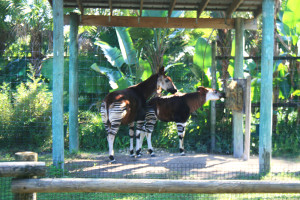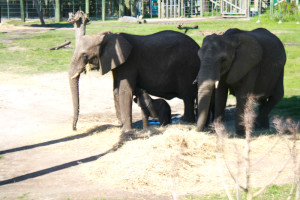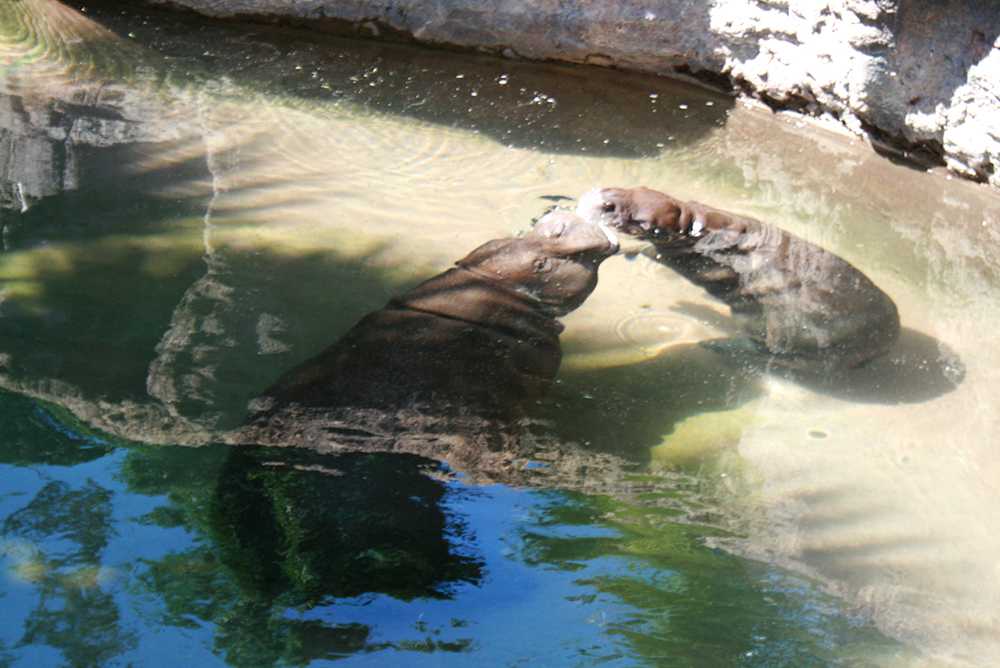Baby boom at Lowry Park Zoo
Zola, pygmy hippo calf, born November 15, 2012.
Lowry Park is kid friendly. Not only because of the Walaroo Station with splash zones and a petting zoo, but you can also meet a new baby animal each month. Since spring of 2012, Lowry Park Zoo animals have birthed over a dozen babies.
Also, in 2012, the American Black Bear “Blossom” was rescued by the Wildlife Center of Montana. The bear is one of two American Black Bears cubs adopted by the zoo this past year. “Newberry”, the second Black Bear, was found in poor conditions by the Florida Fish and Wildlife Conservation.
A Pygmy hippo was born at the zoo November 15, 2012. Guests usually see her playful side early in the morning. When the sun comes out, she is ready to swim around in the shallow pond, wrestling with her mother.
It was a busy Christmas for the keepers at the zoo. The first African Elephant, “Mpumi” was born December 23, 2012. She is a descendant of a rare herd of elephants from Swaziland, Africa. Lowry Park and San Diego Zoo rescued 11 of the pachyderm elephants from being cured a decade ago. A red tailed guenon came days later on December 29, 2012. “Ahnmom” has curious big brown eyes that watch the crowd clinging to his mom. The red tail guenon was initially rescued from bush meat markets in the Democratic Republic of Congo.

To ring in the new year, a rare okapi, “Bahati”, was born January 6, 2013. This unusually looking animal has the legs and stripes of a zebra, the body structure of a horse, and the face of a giraffe. This animal may look like a mixed breed of all three, but it is only related to the giraffe.
After a short 7 month gestation, a beautiful male South African nyala was born March 24, 2013. “Finley” has faint white stripes, shaggy fur, and spiraled horns. He is also one of the many animals that enjoy a shared habitat. This provides more natural habitat and takes advantage of all available land.
An African penguin hatched May 8, 2013. Her name is “Tampanga”. This third batch of hatchlings at the zoo is covered in thick fuzzy grey fur until their black and white color matures. These penguins live in warm weather and seem to enjoy sunbathing instead of ice fishing.
May 25, 2013 was the birthday of a tiny squirrel monkey. This little guy is agile, but he feels most comfortable on his mother’s back most of the day. The baby is more independent and active when eating fruits in the mornings.
A funny story led to another hatchling. Two first time parents, demoiselle cranes, abandoned their egg. Zookeepers quickly moved the egg under a sand hill crane. Both birds have similar migration tendencies and nesting techniques. The bird hatched on May 25, 2013. It stayed with the adoptive mother, the sandhill crane, until August 1, 2013. The crane has since been placed with its parents and is getting along great.
One of the most important animal births occurred at Lowry Park Zoo this year. The birth of “Jiyo” an Indian rhinoceros, made national news on May 29, 2013. This was the third time in the last 5 years that the zoo has a helped make a major contribution to the conservation of wildlife. This endangered species has a birth weight of 75-100 pounds.
A malnourished Florida manatee was also rescued from the Myakka River in Sarasota on July 7, 2013. “Jobin” was only 55 pounds when he was brought to the zoo. Keepers say he will need a minimal of 2-3 years of care before he will be returned to the wild.

Another mark in history occurred July 29, 2013. “Mavi” an African elephant, was born. This is the second elephant baby born to the rescued elephants of the Swaziland herd. The mother elephant was bred with a bull from a different herd giving the offspring a new DNA structure. “Mavi” and “Mpumi” are the first with this gene pool in the United States.
Is Lowry Park Zoo a new breeding ground? It may be. The male black bellied stork was caught making a nest. This very rare bird could be nesting for his mate. Although an egg has not been spotted yet, spectators believe it is soon to come.
The zoo is open 7 days a week from 9:30 a.m .–5 p.m. excluding Thanksgiving and Christmas days. Tickets are $24.95 for adults $19.95 for children. Annual passes start at $95.00 for two Florida residents. Lowry Park has four special days a year with $6.00 admission for everyone. For more information visit: www.lowryparkzoo.com.
Jessica Bartels is a Staff writer of The Hawkeye.
Jessica Bartels was born in Tampa, Florida. The 2005 Gaither High School graduate is a mother...


Melissa • Oct 13, 2013 at 12:54 pm
Hello Jessica,
I learned a lot of cool facts about our very own Lowry Park Zoo. The first African elephant “Mpumi” was born right here in Tampa, Fl, that’s exciting news. Also, this was the first I have ever heard of the rare Okapi, which is a split between a zebra, horse, and a giraffe. I learned a lot of rare creatures were born right here where I live. I will definitely be passing this information along, because these are more than fun facts, they are exciting as well. Never knew Lawry Park Zoo animals birthed over a dozen babies in 2012. I will definitely have to make a trip there as soon as possible. I have only been here 6 years and have yet to experience it. My 3 year old would love to see all the animals interact, and I can’t wait to take them! Enjoyed reading and again learning all the new exciting information.
Thanks,
Melissa
Jessica Bartels • Oct 21, 2013 at 9:55 pm
Hey Melissa and Sandra,
I know that you will both enjoy the zoo. I certainly did. There was so much to see! I know your 3 year old will enjoy it. Mine loved it! She was excited to see that she could feed the giraffes out of her hand. It is a unique experience. I also visited ZooBoo. I was pleasantly spooked! I am glad to see everyone is enjoying The Hawkeye!
Melissa Thornton • Oct 13, 2013 at 12:41 pm
Hello Jessica,
I learned a lot of cool facts about our very own Lowry Park Zoo. The first African elephant “Mpumi” was born right here in Tampa, Fl, that’s exciting news. Also, this was the first I have ever heard of the rare Okapi, which is a split between a zebra, horse, and a giraffe. I learned a lot of rare creatures were born right here where I live. I will definitely be passing this information along, because these are more than fun facts, they are exciting as well. Never knew Lawry Park Zoo animals birthed over a dozen babies in 2012. I will definitely have to make a trip there as soon as possible. I have only been here 6 years and have yet to experience it. My 3 year old would love to see all the animals interact, and I can’t wait to take them! Enjoyed reading and again learning all the new exciting information.
Thanks,
Melissa
Sandra • Oct 9, 2013 at 2:14 pm
I was unaware of all of the new baby animals that have been born at the Lowry Park Zoo. Twelve have been born since last spring which is amazing. I am anxious to visit to see the African elephant that was born December 23, 2012. I think that I saw her mother the last time I was at the zoo. My personal favorite animal is the penguin. I love the tribute the zookeepers made to our city by naming her Tampaniga! I never knew how penguins could survive in our warm weather but was glad to learn that this African species loves the sun. I am hoping to make a visit to the Lowry Park Zoo very soon.
Buddy • Oct 3, 2013 at 9:43 pm
What exciting news for the zoo! My wife and I recently took our daughters to the Lowry park zoo using our “swaptember” passes. Everyone had a great time. Unfortunately we didn’t get to see all of the new arrivals, but we were excited to see the new Pigmy hippo, Zola. We were there in the afternoon so she mostly was hanging out in the little shallow pond there with her mom. I did notice the dad in the enclosure with them, and was curious about that. I know that male hippos in the wild can be very aggressive towards young, so it was interesting to learn that it not the case with the pigmy hippo- at least not ones in the zoo. More research needed I guess.
You didn’t mention any Orangutans as recent additions to the zoo. While we were there we saw one that looked much younger than the rest, and were wondering when he (or she) was born. Must not have been within the last two years though, so perhaps it was older than we assumed.
Jessica Bartels • Oct 21, 2013 at 9:47 pm
Hey Buddy according to public relations at the zoo the orangutans youngest is a 5 years old, a female named “RanDee”.